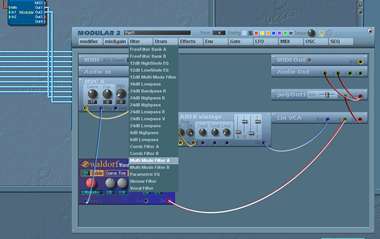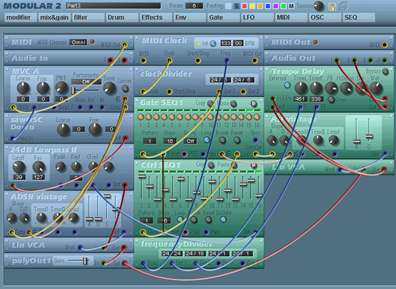|
|
|
|
|
|
Review: Creamware Pulsar 2
By Manuel
Clement
(August 10, 2000)
Model: Pulsar 2
Company: Creamware
Compatibility: Mac, PC

Creamware is
a company designing sound cards, but their sound cards are quite
different from what most of the competition is offering; they are
building DSP systems dedicated to process all the audio routing you
may dream about, apply effects in realtime, run software
synthesizers, without using any of your computer's processor power.
It sounds good that's what Pulsar 2 is all about.
Overview
Today I am reviewing the Pulsar II, the
standard version (Model Classic 20). Six SHARC DSP chips are on the
board, delivering a good amount of power to run your virtual studio.
You can add any Creamware DSP card in, and the Pulsar software will
detect the new I/Os and the additional DSPs available, enabling you
to do more processing. This makes the Creamware cards very
expandable. The connectors available on this version are: 1 x analog
I/O, 1x S/PDIF I/O, MIDI IN OUT THRU, 16 ADAT channels (EIAJ
connectors).
If you wish to expand your DSP system with
additional analog I/Os, you can add a Luna 2496 I/O Box. This box
has 8 ins, 8outs (simultaneous). There is also the A16 Ultra, as
they call it "The Audiobahn", which features an outstanding set of
16 INs and 16 OUTs with a double ADAT interface and Z-Link.
Host computer: avoid VIA chipset motherboards
The Pulsar
II works like a charm on both Mac and PC systems. Note that Windows
2000 is not supported yet. You may run into problems with some
motherboards for AMD processors that are built around a VIA133
chipset. The Pulsar II runs ok on them, but other motherboards would
be a lot better, to fully exploit the power. The best is to get a
different motherboard. It seems that most Intel or Mac people won't
have much problems.
Setup
The computer I am using to test the Pulsar II is
an AMD Athlon 900Mhz with 512MB of RAM, Abit KA7-100 VIA133 chipset
motherboard... If you are reading carefully this page, you'll notice
I just mentionned that the VIA133 chipset is not the best to get
with the Pulsar II.. Yes, but this is a good chance to see if our
DSP system runs anyway. One more thing, I have Powertweak II
installed and set to "optimize", which should solve the problems.
Additionally, for this test I will use a standard MIDI keyboard
controller, and two amplified studio speakers: Event 20/20bas.
Software-wise, I will test it with Cubase VST 5.0, Propellerhead
Reason 1.0, and Digidesign Pro Tools Free.
Pulsar OS: the virtual studio

If you love
technology, you will feel like a fish in the ocean. It is the heart
of your studio. You drag and drop elements from the library to the
stage and start building your own custom studio, from the sound
sources (ASIO, DirectSound, Windows Sound, P2 analog source...),
mixers, to the effects (flangers, compressions, chorus, decimators,
vocoders, reverbs...). Once your studio is built, you drag and drop
your sound generators, which can be synthesizers, sample players,
modular synthesizer, etc.. You can drag and drop as many as you
want, as long as you have enough DSP power. Note that everything you
create inside the OS is not affecting the performances of your
computer, because the card is rendering all the devices and signals
in realtime using the DSP power. To plug studio elements together,
you simply connect them with cables as you would do in a real
studio. Everything you do is saved in a unique "project" file, very
useful as this enables you to have a custom studio for each
song/project.

Synthesizers
I liked the sound of most of these
synthesizers. The miniscope can generate nice minimoog tones, while
the FM-one is an FM synth. The best is to listen to some demos I
recorded with each of them:
Blue Synth: mp3 demo
EDS8i (analog drum synth) : mp3 demo
EZ Synth: mp3 demo
FM One: mp3 demo
Inferno: mp3 demo
Miniscope MK2: mp3 demo
U Know 007: mp3 demo
Modular II
The modular II is fantastic. You get more
than 140 modules (!), and you can drag and drop them to build your
own modular synthesizer, plug those cables, and hear in realtime how
it sounds!

Note that
the Modular II used to be a bonus when you registered your Pulsar
II. In the future, you'll have to buy it, and the bonus will be the
"poison", a nice synthesizer device for your Pulsar. I strongly
recommend you to buy the Modular II though, as it is an amazing
device. The modular II will be sold for 198 Euros. Note: check
creamware.com for the latest offer to date; they often change their
prices.

Effects
A studio is only good if you have decent effects
to work with. Pulsar comes with several effects, let's see how they
work. You can route any signal into any DSP effect in real time. It
means that it works exactly like if you had a hardware multi-effect
rack. Some of the effects I really dug during my test are:
decimator, dither/shaper, ring modulator, 4-Pole filter.
Here
are a few demos I recorded with the effects:
Decimator: mp3 demo
Ring Modulator: mp3
4 Pole Filter: mp3 demodemo
Decimator: mp3 demo
All of the above connected in
chain: mp3 demo

These are
just four of the several effects you get with the Pulsar II package.
If I wanted to make you listen to all of them it would take a whole
review. This card deserves the best ratings when comes to real time
effects. You can route any sound signal to any of the device, or
even plug ALL of them to affect your sound.. You can imagine the
possibilities.. Since it is processed in real time, you can hear the
effects applied to the signal as you hit you keyboard
keys.
The only thing that is not perfect yet is the reverb.
But a representative of Creamware told me that they will release
"Masterverb" very soon, which should give you the same result as
high-end hardware reverbs. This reverb will be included in the next
update of the Pulsar OS, which is free. Good news.
Last
minute note: the new reverb is out. It is called Masterverb.
Pulsar 2 with Cubase VST32 5.0
Cubase 5 works with
ASIO I/Os so I made a pulsar project that would enable me to route
the pulsar's outputs to Cubase's ASIO inputs. It worked very well. I
was able to record the signals of several devices on separated audio
tracks, keeping everything in the digital domain from sound
generation to medium. The latency time was down to 7 milliseconds at
44.1Khz. Controlling the Pulsar devices via MIDI from Cubase was
very easy too.
Note: you can go as down as 1ms at 96Khz, but
you may get some glitches, so it is safer to tune the latency (ULLI
settings) to 7 ms or 13ms. I had to tune to 13ms 44.1Khz using a lot
of devices to get a perfect sound, but the latency seemed short and
fine anyway.
Pulsar 2 with Reason 1.0
Like Cubase, Reason works
with ASIO. When using the Pulsar II as the audio driver, I got the
latency time down to 7 milliseconds. Note that I wasn't able to run
Reason when the Pulsar sample rate was set to 96Khz or 48Khz, it
only worked at 44.1Khz.
Pulsar 2 with Pro Tools Free
Pro Tools FREE is
basically the non-hardware version of Pro Tools, and it is free. The
thing is that this program doesn't work with ASIO, so the timing was
not very good. It did record audio quite well, but I had to mute the
audio channels as they were recording, otherwise there was a
terrible echo/resonance. When the rec audio channels were muted, I
was able to record correctly, and when I played the tracks back, I
didn't notice any artefact in the sound. Pulsar II and Pro Tools
Free = great recording quality, but weak timing, due to the fact
that Pro Tools free is not working with ASIO drivers. Pro tools
works with MME
Devices at a glance
Sound
Generators:
BlueSynth
EDS8i (drum synth)
EZ Synth
FM One
Inferno
miniscope
miniscope MK II
U KNOW
007
14 Modular Synth patches
Vocoder
Vocoder 2
Sample Player
Sample Player F
Mixers:
Dynamic Mixer
Big Mixer
Big Mixer
V2B
Hardware I/O modules:
16 channel ADAT In/Out
2 channel Analog In/Out
2 channel S/PDIF In/Out
Midi
In/Out
8 channel ADAT S/MUX 24/96 (requires Pulsar II hardware)*
Syncplate source (requires optional Sync Plate)
Driver Devices:
32 channel ASIO In/Out, 16 &
24 bit
32 channel ASIO2 In/Out, 16 & 24 bit*
32 channel
EASI In/Out (with Mixing on DSPs)
16 channel tripleDAT 16 In/Out
32 channel GigaSampler Interface In (source)*
16 channel
Wave Interleaved driver In/Out
multiple stereo Wave In/Out, 16
& 24-bit
multiple Sound Manager In/Out
Direct Sound In
(source)
multiple Sequencer MIDI In/Out
MTC to Clock
Sound Card(s) In/Out
External Effects
remote:
MIDI Remote
MIDI Remote Box
MIDI Remote Fader
MIDI Remote Box Fader
AUX Effects:
Cross
Delay
Cross Flanger
Cross Phaser
Mini Verb
Stereo
Chorus
Stereo Delay
Stereo Flanger
Stereo Phaser
Insert Effects / Mono:
4-Pole Filter
Compressor E*
Decimator
Dither / Shaper mono
EQ SP2
(2 band shelving, 2 band parametric)*
Gate
High Cut*
Limiter E*
Low Cut*
Mono Compressor
Mono Delay
Mono Flanger
Mono Insert Rack
Mono Limiter
Mono
Phaser
Parametric EQ 4 mono
Ringmodulator
Insert
Effects / Stereo:
4-Pole Filter Stereo
Compressor E*
Dither / Shaper stereo
EQ SP2 (2 band shelving, 2 band
parametric)*
Feedback Chorus A
Feedback Chorus B
Limiter
E*
Multiflanger
Stereo Compressor
Stereo Decimator
Stereo Insert Rack
Stereo Limiter
Miscellaneous:
Key Splitter
MIDI Merger
Sequencer Remote Control
lots of Presets for all devices
*new in version 2.0
Conclusion
What a card! The future seems great too
for Creamware, who announced Pulsar XTC, which enables you to use
the Creamware devices inside Cubase VST. Someone from Creamware has
recently posted this message on a message board "The next Pulsar
version will include the XTC interface so that you can use all the
modules directly from within your VST-compatible sequencer". Stay
tuned to FutureProducers.com, as there will be other reviews of
Creamware cards and devices!
Last minute note: Creamware
has released XTC and this feature is now included by default in all
soundcards, via a new unified Operating System: SFP (Scope Fusion
Platform) 3.1a.
 Read more
Exclusive FP Features Read more
Exclusive FP Features
|
|
|
|
| |
|
Auctions!
Hot Music Gear
Exclusive FP Features

MMhhhh molded HardBody shell,
velvet-lined interior... Mano looks at Slappa's CD/DVD cases.

Mano reviews MPC Drum, the krunchy, crusty, dirty and
filthy sound collection.

David Gibb explores the Nuo-5 mixer from Ecler.
Check out the full review of the beast, with pictures and video!
 More
Features More
Features
|
| |